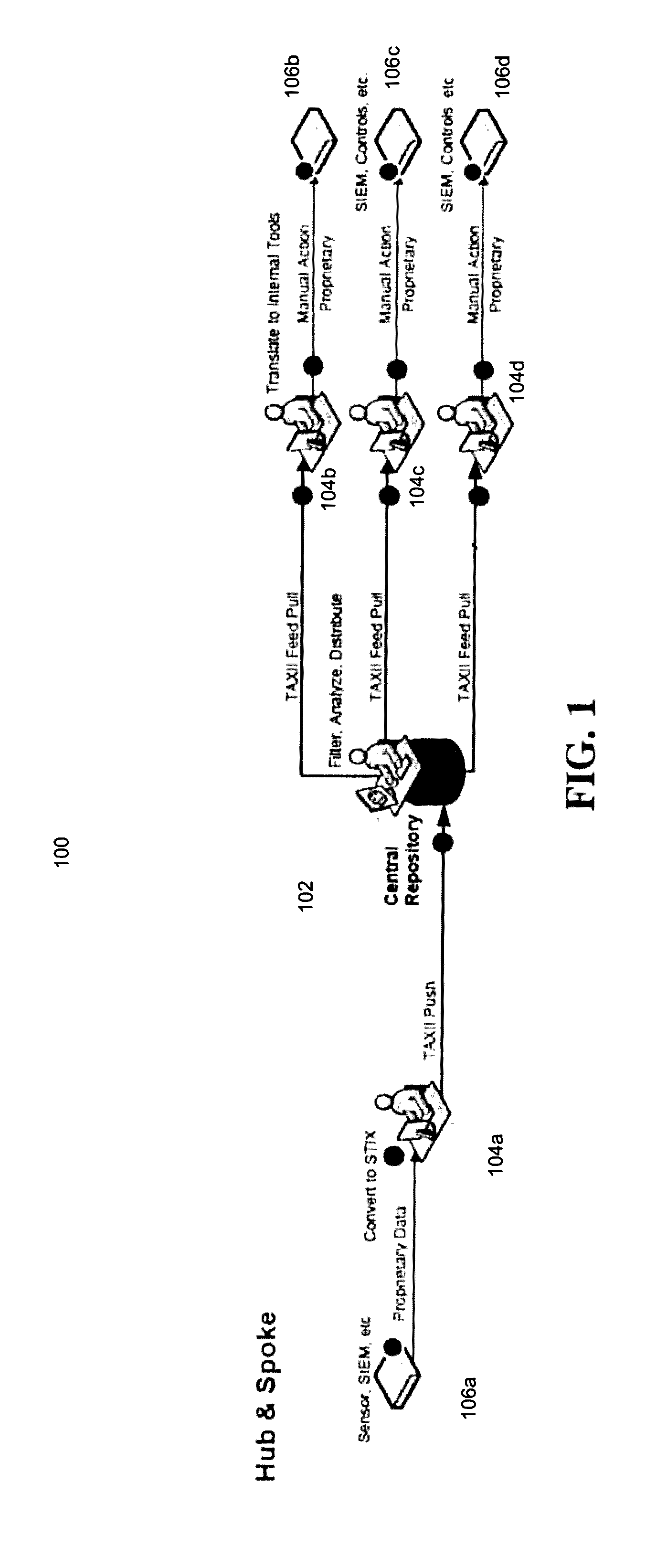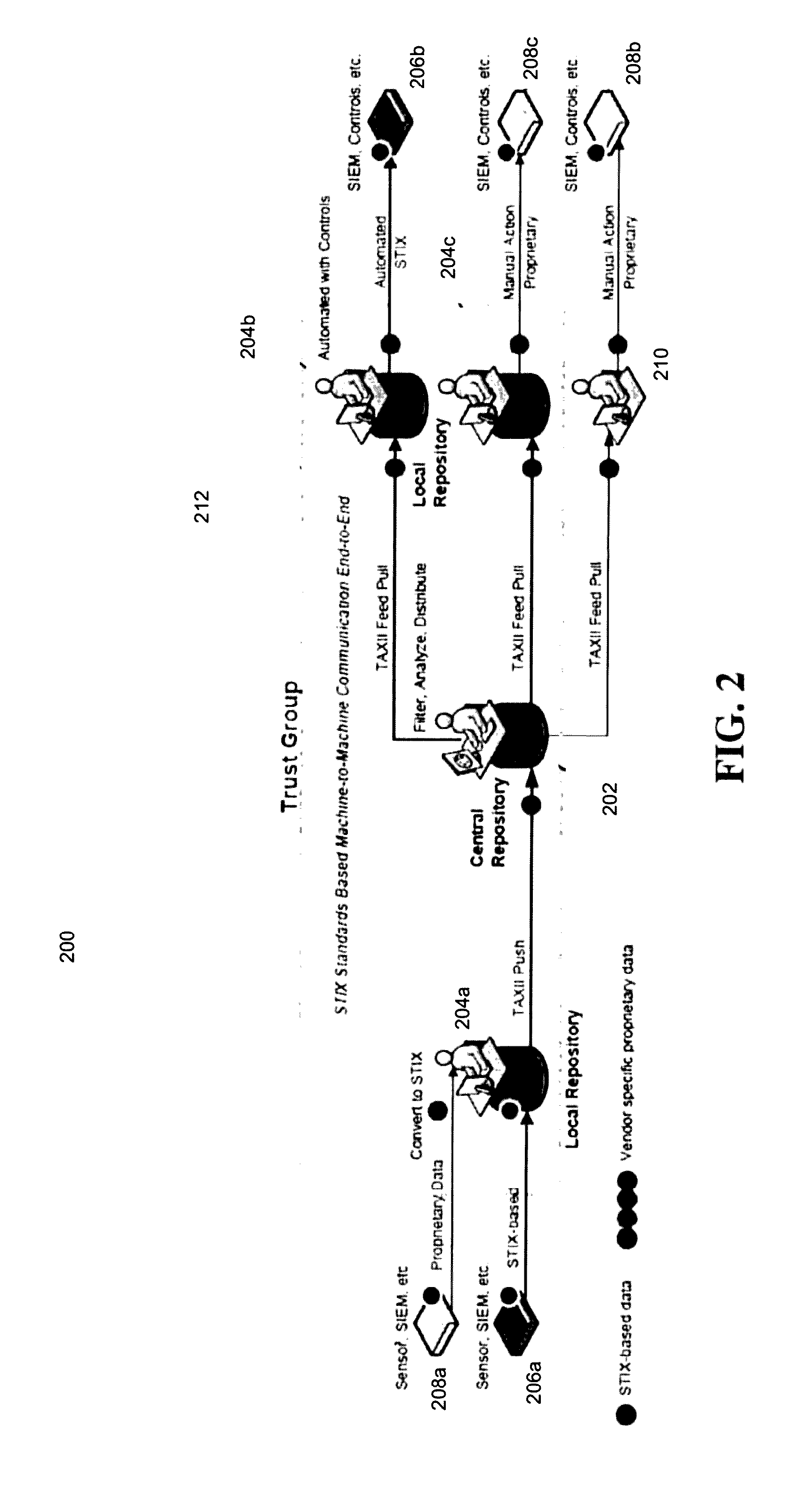Computerized system and method for securely distributing and exchanging cyber-threat information in a standardized format
a computerized system and cyber-threat information technology, applied in the field of computer-implemented systems and methods, can solve the problems of compromising the crucial infrastructure of utilities, obtaining trade secrets from corporations, and obtaining personal information from bad actors, so as to increase the complexity and impact of cyber-threats, not only in the number, but also in the complexity
- Summary
- Abstract
- Description
- Claims
- Application Information
AI Technical Summary
Benefits of technology
Problems solved by technology
Method used
Image
Examples
exemplary embodiment 100
[0034]FIG. 1 illustrates a first particular exemplary embodiment 100 of the threat information-sharing systems and methods of the present invention, known as a “hub & spoke system.” In this type of system 100, one or more central repositories 102 and a plurality of users 104a, 104b, 104c, and 104d communicate items of threat information in a common language and distribute those items of threat information in accordance with a common specification.
[0035]The one or more central repositories 102 may each be hosted on one or more servers. In some embodiments of the invention, each server features at least one multi-core processor. In some embodiments of the present invention, the central repository 102 is a software image that is loaded onto and hosted by the one or more servers.
[0036]In some embodiments of the invention, the central repository 102 is a document-oriented, NoSQL database. In certain embodiments of the invention, the document-oriented, NoSQL database is a MongoDB database...
exemplary embodiment 200
[0052]FIG. 2 illustrates a second exemplary embodiment 200 of the “hub & spoke system” that incorporates an “access control” or “trust” group 212, and local repositories 204a, 204b, and 204c. Like central repository 202, these local repositories 204a, 204b, and 204c are capable of storing, filtering, analyzing, and distributing items of threat information detected by SIEM sensors and controls 206a, 206b, 208a, 208b, and 208c.
[0053]In certain embodiments of the invention, some of the SIEM sensors and controls, such as 206a and 206b, generate and act on items of threat information in the common language of the threat information sharing system 200, instead of SIEM sensors and controls such as 208a, 208b, and 208c that generate and process items of threat information in customized, machine-readable languages. In these embodiments of the invention, local repositories such as 204a and 204b do not need to translate the information received from SIEM sensors and controls 206a and 206b bef...
exemplary embodiment 300
[0059]FIG. 3 illustrates a third exemplary embodiment 300 of the threat information-sharing systems and methods of the present invention, known as a “hub & spoke” plus “peer-to-peer” system. In this exemplary system 300, the local repositories 304a, 304b, 304c, and local entity 306 can provide threat information detected by their SIEM sensors and controls 308a, 308b, 308c, and 308d to central repository 302, which can distribute the received items of threat information to the other local servers, in “hub & spoke” mode (as illustrated by FIGS. 1 and 2).
[0060]In addition to “hub & spoke” mode, however, exemplary threat information sharing system 300 can also operate in “peer to peer mode,” where local repository 304a can share threat information directly with another local repository, such as repository 304b as illustrated by FIG. 3.
[0061]In some embodiments of the present invention, local repositories 304a and 304b can synchronize the threat information they contain at scheduled time...
PUM
 Login to View More
Login to View More Abstract
Description
Claims
Application Information
 Login to View More
Login to View More - R&D
- Intellectual Property
- Life Sciences
- Materials
- Tech Scout
- Unparalleled Data Quality
- Higher Quality Content
- 60% Fewer Hallucinations
Browse by: Latest US Patents, China's latest patents, Technical Efficacy Thesaurus, Application Domain, Technology Topic, Popular Technical Reports.
© 2025 PatSnap. All rights reserved.Legal|Privacy policy|Modern Slavery Act Transparency Statement|Sitemap|About US| Contact US: help@patsnap.com



